FAQs
atDNA in Depth
Autosomal DNA or atDNA pertains to the genes or genetic markers in any chromosome other than the sex chromosomes (XX or XY). In humans, autosomes are the set of chromosomes labeled 1 to 22. Chromosome 23 is the sex chromosome. See the chart below, Chromosomes in Human DNA. Also here is a link to a video about about Autosomal DNA at Sorenson Molecular Genealogy Foundation and here is a link to a discussion by Dr. Erin Cline Davis of 23andMe.
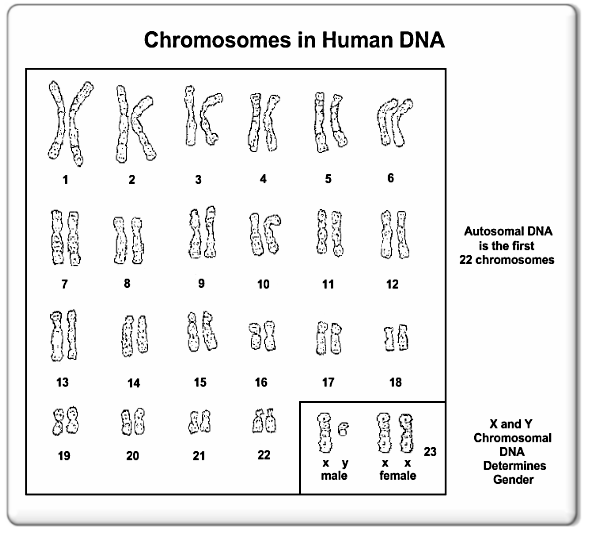
Since autosomal DNA or the atDNA is made up of many random combinations of genetic blocks of information, its uses in genealogy have been limited thus far.
Because all atDNA does not combine in a definitive pattern, some atDNA is inherited in a larger quantity than other atDNA. For example, a son may inherit more atDNA from his mother than from his father.
As it was stated above, the "recombination" of atDNA is random. Scientists still do not completely understand the random "recombination," but have been developing theories on it.
To illustrate this random "recombination" of atDNA, see the chart with colored graphics below called, Autosomal DNA Random Recombination.
In the chart, color is used to show the atDNA of two children and their direct ancestors, mother, father, grandparents, etc. The oldest generation is shown with a solid color, that is randomly "recombined" in the child of the next generation and so forth until the parents of the two children are shown at the bottom. The two children, a brother and sister, contain all the randomly "recombined" atDNA of all their ancestors.
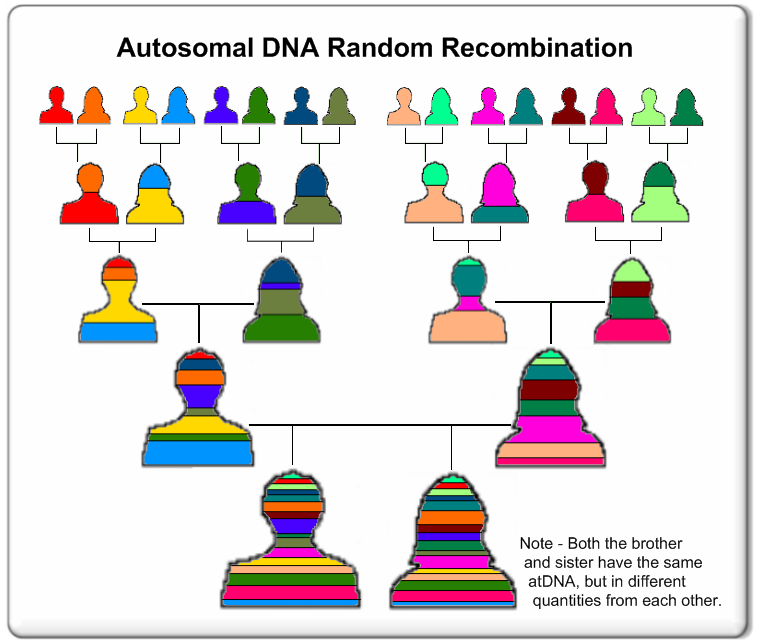
atDNA Uses for Genealogy
Before talking about autosomal DNA (also known as atDNA) for use in genealogy, it is important to understand more about atDNA and its function in a person's total DNA. Understanding this information and what atDNA can and can't tell you will help in determining your choices if you decide to pursue atDNA genetic testing.
Autosomal DNA testing for genealogy at the current time is controversial, expensive, complicated and less informative than yDNA and mtDNA testing. Currently, autosomal DNA can only tell us about our recent genetic past and our deep ancestry. Another FAQ article if you would like to learn more about atDNA in depth.
Autosomal DNA's Main Uses
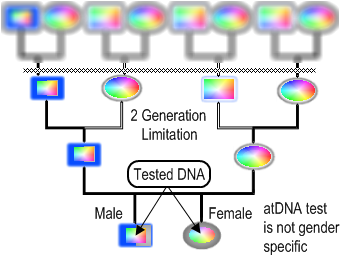
The main function of autosomal DNA is to pass on physical characteristics such as hair or eye color, skin complexion, height, weight, facial features and medical traits.
Autosomal DNA is used in proving paternity and it can be used to research extended family members within 2 generations, i.e. a grandchild to a grandparent. There are some new atDNA tests that claim the ability to give results back 4 generations, but they are not proven yet. Autosomal DNA testing works equally well in either a man or a woman.
The police and forensic labs use atDNA to prove a person is unique. This type of information is on the opposing side of genetic genealogy because by testing yDNA and mtDNA someone can prove a genetic relationship to another person many generations in distance.
Two Types of Autosomal DNA Tests
Right now there are two types of tests for atDNA for genealogical use; they are Codis and Biogeographical. Deciding on which company a person uses to test his or her atDNA depends on what type of information you are seeking. Codis results are a vague series of numbers that must be interpreted by a genetic professional.
The Codis test is the test used for paternity to prove close relationships (child to father and mother) or by police and forensic departments to prove uniqueness. One company claims to have a database with sufficient data to provide a snapshot of a person's ethnic heritage geographically based on Codis Results.
Biogeographical atDNA testing to determine genetic percentages of a person's ethnic ancestry from continental regions uses a mix of SNP's (single nucleotide polymorphisms) across a range of individual and family chromosomes. In the genome being analyzed, the chromosomes are compared with population databases. Depending on the testing company, the use of standard Codis markers combined population databases like OmniPop are used to identify test subject's percentages of Native American, Indo-European, East Asian or Sub-Saharan ancestry. The four biogeographical groups are defined and reported as a percentage of DNA make-up as follows:
- Native American: Populations that migrated from Asia to inhabit North, South and Central America.
- European: European, Middle Eastern and South Asian populations from the Indian subcontinent, including India, Pakistan and Sri Lanka.
- East Asian: Japanese, Chinese, Mongolian, Korean, Southeast Asian and Pacific Islander populations, including populations native to the Philippines.
- African: Populations from Sub-Saharan Africa such as Nigeria and Congo region.
Another biogeographical testing company professes to know what markers to test for ethnic background and a series anywhere from 500 to 1349 markers are tested. Some offer a more detailed test to determine regions of a continent a test subject appears through probability to have more relationship through atDNA. As of right now a more in-depth look at Indo-European or "European" ancestry is now being offered with a map showing probabilities of frequency of a test subject's atDNA geographically illustrated in Europe.
Some companies that test atNDA are DNA Tribes, mygeneTree, DNA Print Genomics, 23andMe and DeCodeMe.
Making the Choice to take an atDNA Test
To make a final determination about atDNA testing, you must realize that at this time, atDNA can not be used for genealogy in the same way that yDNA and mtDNA can be used. Autosomal DNA testing is more for those who are trying to find clues to possible ethnic heritage.
As scientist Roberta Estes, has stated: "Clearly understand that the tribes [sic, DNA Tribes] information (as well as any other autosomal analysis information of this type) should be chocked up to the 'interesting' category, and little more until the underlying data bases and technology becomes significantly more robust."
Uses of atDNA and information on atDNA is changing rapidly as this type of testing becomes more developed. If you can add more or correct information that has changed, please use our contact form to notify the webmaster.
What are the fastest mutating markers in Y-DNA?
The five fastest moving Markers are: DYS 464, 449, 439, 385, and 458
DYS 464 is the fastest moving marker and DYS 458 is the slowest in this group of the five fastest moving markers. The other three listed markers fall between the fastest and the slowest of the fast moving markers. There are also other fast moving markers, such as DYS 456, 576, 570 and CDY.
For now we will just address the first 37 markers tested at FTDNA, since the 37 marker test seems to be the test of choice for yDNA testing. When you examine the first three panels, 1-12, 13-25 and 26-37, these are the fast moving markers used in each panel at FTNDA:
First panel, 1 through 12 markers: DYS 385 and 439
Second panel, 13 through 25 markers: DYS 458, 449 and 464
Third panel, 26 through 37 markers: DYS 456, 576, 570 and CDY
As you can see, the markers in the first panel are the most stable and are generally the slowest to mutate, the second panel contains markers that are a little less stable, and the third panel is the most unstable and contains the fastest moving markers. To learn more about the specific mutation rates of each marker above and the more stable markers, this link(http://en.wikipedia.org/wiki/List_of_DYS_markers) will take you to a website that covers this topic.
Fast mutating markers called multi-copy markers.
A few of the fast mutating markers such as DYS 464, 385, and CDY are multi-copy markers. This type of marker is defined by the fact that more than one copy of the marker exists on the Y chromosome. These types of markers bear an additional designation suffix. DYS 464 is broken down into 464a, 464b, 464c and 464d. Some people (less than 5% of the population) also have 464e, 464f and 464g. DYS 385 is known as 385a and 385b just as DYS CDY is known as CDYa and CDYb.
These multi-copy markers are very useful for determining relatedness with a small amount of comparable markers and will also help differentiate branches within a family group of participants as stated above. Results are reported in ascending order for multi-copy markers. It is important to know how to read the results for these multi-copy markers and they can be a confusing, until you know how to compare them. For example let's consider two Prichard men who match perfectly on all but the marker DYS 464.
Suppose these two individuals marker value were this:
| Name | DYS 464a | DYS 464b | DYS 464c | DYS 464d |
| John Pritchard | 15 | 15 | 16 | 17 |
| Eli Pritchard | 13 | 15 | 15 | 17 |
Upon first appearance, one might think they are two steps away from each other. It is common to line up the results and look at 15 over 13 and 16 over 15 and think there are two mismatches. This is not the case since the markers are read in ascending order. John Prichard has a 15, 15, 16 and 17. Eli has a 13, 15, 15 and 17. They both have 2 values of 15 and 1 value at 17. They match on 3 out of 4 markers within the multi-copy marker of DYS 464. In other words, this mutation only represents a genetic distance of 1, not a genetic distance of 2.
Another example:
| Name | DYS 464a | DYS 464b | DYS 464c | DYS 464d |
| John Pritchard | 11 | 11 | 14 | 16 |
| Eli Pritchard | 12 | 14 | 15 | 16 |
Here most would think there are 3 mismatches in these results. However, there are only 2 mismatches within these results. John and Eli both have values of 14 and 16; however, John has values of 11 twice and Eli has a 12 and a 15. This represents a genetic distance of 2, not 3.
Your Total DNA Makeup
What makes you who you are? There is no easy way to define this because the majority of any human's DNA is a random combination of his or her direct ancestors' DNA. The only two types of DNA that are completely definable and constant are yDNA and mtDNA, because they are non-recombining.
A man will inherit four types of DNA from his parents, those are: from his father (yDNA), from his mother (mtDNA and x-chromosomal DNA) and from both parents, their randomly combined atDNA known as autosomal DNA. A man's yDNA and mtDNA are only a very small fraction of his total DNA, less than 1% each. For x-chromosomal DNA, scientists estimate it is 2 1/2% of a man's total DNA.
For a woman she will only inherit three types of DNA from her parents; from her mother (mtDNA and x- chromosomal DNA), from her father (his mother' x chromosomal DNA) and from both parents, their randomly combined atDNA. In a woman while mtDNA percentages are the same as a man at less than 1%, her atDNA is lower percentage of her total DNA because a female carries two x-chromosomes and her x-chromosomal DNA is estimated at 5% of her total.
From the figures above and in the chart below, it is easy to see that the majority of DNA in a man or a woman is atDNA. Even though x-chromosomal DNA is randomly recombined like autosomal DNA, there is scientific evidence that it is not the same as autosomal DNA.
See the chart below to view a man's 4 types of DNA and a woman's 3 types of DNA.
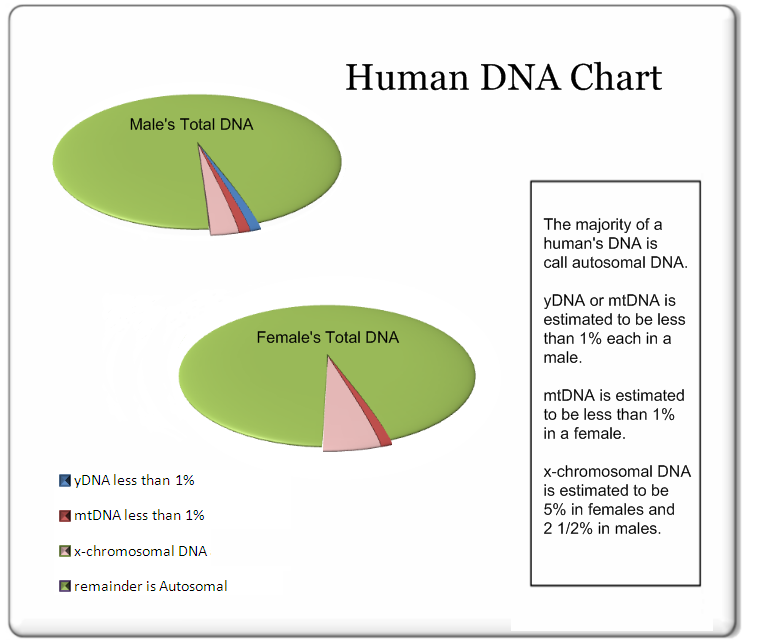
So how is DNA passed down from a father and mother to their children and their children's children, and so on? The chart below shows the 4 lines of DNA, yDNA, mtDNA, x-chromosomal and autosomal DNA(atDNA). A multicolor graphic is used because the autosomal DNA from a mother and father and x-chromosomal DNA from a mother only is completely random and there is no exact way that this type of DNA combines to be passed from a mother and father to their children.
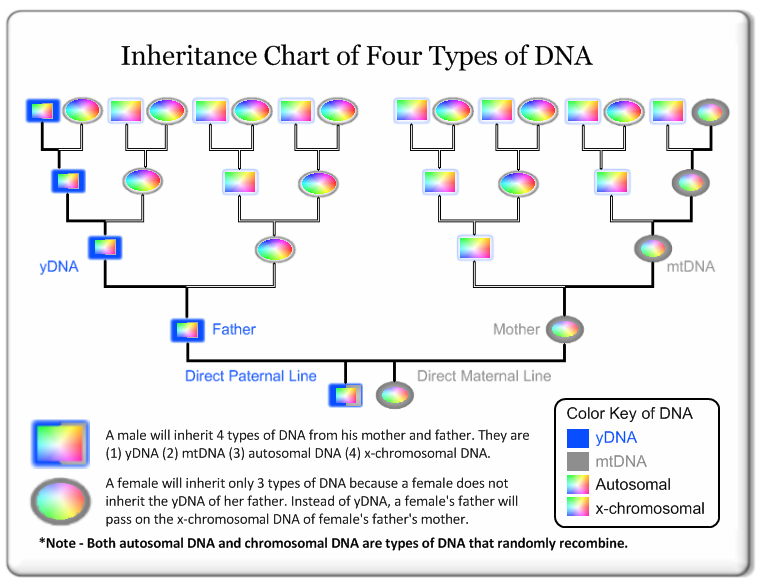
Now that you understand about the types of DNA you should know that x-chromosomal DNA for genealogy is completely new and still being researched. Most genealogists already know about yDNA and mtDNA testing. The other DNA left is autosomal DNA. Since scientists have been working on using autosomal DNA for genealogy the next question might be...
Read This Before You Order Your DNA Test
If you are considering DNA testing for genealogical research, you need to be aware of a few things before you take the plunge and order your first DNA test. The following information can save you a lot of money and time. Of course if you have unlimited funds and time, by all means, take every test available. The more you test, the better your chances of finding a match to your DNA.
Important things to remember:
1) The largest study groups of DNA used for genealogy is Y-DNA Surname Projects, like this project, they only study connections of Y-DNA. Y-DNA is the most reliable, oldest and accurate method of DNA testing for genealogy. There is no other DNA type that can do what Y-DNA does to advance your genealogical research.
2) If you are a male, the first DNA test you should always take is a Y-DNA STR marker value test. Taking an atDNA(autosomnal DNA) test will not give you any additional information unless someone else has atDNA tested, and the connection is close, 3rd - 5th cousins. Even then, an atDNA test might say you aren't related, when in fact you might be. atDNA dilutes with every generation.
3) If you are a female, you should explore methods of getting a male relative to test their Y-DNA. You can always manage their test results.
4) Ask questions before your order a test. Know what you want to learn, know what to expect from the test you order.
5) There is no DNA test can reveal your family origins geographically. The ties to geographic locations are based on information provided by those who tested and provide their origins. Not everyone does this, nor is their a review of accuracy in the data that is provided. In simplest terms, don't expect to test and then be told your family is originally from Scotland. DNA testing just doesn't work that way.